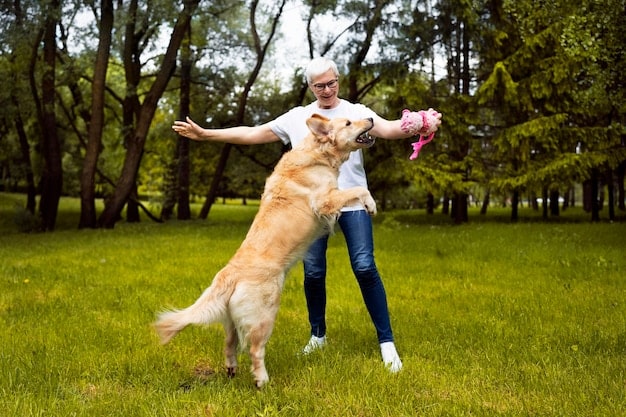How to Stop Dog Barking in Under 7 Days: 2025 Expert Guide

How to Stop Your Dog’s Excessive Barking in Under 7 Days: A 2025 Guide involves identifying the cause of the barking, implementing consistent training techniques, and using tools to help manage and reduce unwanted barking behavior effectively.
Is your dog’s barking driving you (and your neighbors) crazy? You’re not alone! How to Stop Your Dog’s Excessive Barking in Under 7 Days: A 2025 Guide offers practical, updated strategies to help you regain peace and quiet. Let’s dive into proven techniques for a happier, quieter home.
Understand Why Your Dog Barks Excessively
Before you can effectively address your dog’s barking, you need to understand the reasons behind it. Dogs bark for various reasons, and identifying the trigger is crucial for developing an effective training plan. This section will explore common causes of excessive barking in dogs.
Common Reasons for Barking
Dogs use barking as a way to communicate. Understanding the different reasons can help you tailor your approach.
- Territorial Barking: This type of barking occurs when your dog perceives a threat or intruder to their territory. It is often accompanied by alert postures and can be directed at people, animals, or even vehicles passing by.
- Attention-Seeking Barking: Some dogs bark to get attention from their owners. They may have learned that barking leads to petting, playtime, or treats.
- Anxiety and Fear-Based Barking: Dogs suffering from anxiety or fear may bark excessively when left alone (separation anxiety) or when exposed to unfamiliar environments or stimuli.
- Frustration Barking: This occurs when a dog is unable to access something it wants, such as a toy, food, or social interaction.
Identifying which type of barking your dog exhibits will dramatically impact the efficacy of your training strategy. Observe your dog’s body language and the circumstances surrounding the barking to identify the root cause.
Understanding the reasons behind your dog’s barking is the first step in addressing the issue effectively. Once you know why your dog is barking, you can begin to implement strategies to manage and reduce the behavior.
Assess Your Dog’s Environment and Routine
Your dog’s environment and daily routine can have a significant impact on their barking behavior. Making adjustments to their surroundings and schedule can sometimes lead to a noticeable reduction in excessive barking. Let’s examine how you can evaluate and modify these factors to optimize your dog’s behavior.
Environmental Enrichment
A stimulating environment can reduce boredom and anxiety, decreasing the likelihood of excessive barking.
- Provide Interactive Toys: Puzzle toys and treat-dispensing toys can keep your dog mentally stimulated and occupied.
- Rotate Toys Regularly: Keep your dog interested by rotating their toys every few days.
- Create a Comfortable Space: Ensure your dog has a comfortable, safe space where they can relax and feel secure.
Routine and Exercise
A consistent routine and ample exercise can help reduce stress and pent-up energy, leading to less barking.
Adequate physical exercise reduces boredom and pent-up energy that can cause excessive barking. Regular walks, play sessions, or even fetch can make a big difference.

Modifying your dog’s environment and routine involves making changes designed to minimize triggers and fulfill your dog’s needs. When these alterations are aligned, it can lead to decreased levels of boredom and anxiety, as well as fewer opportunities to practice unwanted barking behavior.
Start Basic Obedience Training
Basic obedience training is an essential component in managing and reducing excessive barking. A well-trained dog is more likely to respond to commands and less likely to engage in unwanted behaviors, including excessive barking. Here’s how to incorporate obedience training into your strategy.
Essential Commands
Focus on foundational commands that give you more control over your dog’s behavior.
- “Quiet” or “Enough”: Teach your dog a specific command to stop barking.
- “Sit” and “Stay”: These commands can help redirect your dog’s attention and calm them down.
- “Leave It”: Useful for preventing barking at objects or people.
Teaching a “quiet” or “enough” command: When your dog starts barking, say the command clearly and firmly. If your dog stops barking, even briefly, reward them immediately with a treat and praise. Repeat this process consistently.
Regular practice, positive reinforcement, and consistency are key elements of successful obedience training. Incorporating these can lead to a marked decrease in barking, providing that you have consistent implementation.
Use Positive Reinforcement Techniques
Positive reinforcement is a highly effective method for modifying your dog’s behavior and reducing excessive barking. By rewarding desired behaviors, you can encourage your dog to repeat them while discouraging unwanted actions. Let’s explore how to use positive reinforcement techniques effectively.
Focus on rewarding silence: The core principle of positive reinforcement is to immediately reward your dog when they exhibit the desired behavior. When your dog is quiet, even briefly, provide a treat, praise, or a favorite toy.

Effective positive reinforcement techniques require consistency, timing, and an understanding of what motivates your dog. When you use these techniques effectively, it becomes easier to discourage barking in favor of more appropriate responses.
Consider Bark-Control Devices (With Caution)
Bark-control devices can be a controversial but potentially useful tool in managing excessive barking. These devices are designed to discourage barking through various means, such as emitting sounds or providing mild corrections. However, it’s important to use them cautiously and ethically. Let’s examine some common types of bark-control devices and how to approach their use.
Types of Bark-Control Devices
There are several types of devices including:
- Ultrasonic Bark Deterrents: These devices emit a high-frequency sound that is audible to dogs but not to most humans. The sound is designed to startle the dog and interrupt the barking behavior.
- Citronella Spray Collars: When the dog barks, the collar sprays a burst of citronella, which most dogs find unpleasant.
- Vibration Collars: Emit a vibration on the dog’s neck when it barks, serving as a distraction.
When using any bark-control device, start with the lowest setting (if applicable) and monitor your dog’s reaction. The overall goal is to provide just enough correction to interrupt the barking without causing undue stress or fear.
Bark-control devices may work for some dogs, however, they are best utilized as part of a comprehensive behavior modification plan that includes training, environmental management, and addressing the underlying cause of the barking. It is highly advised that you consult with a professional trainer, or vet, before getting one of these.
Maintain Consistency and Patience
Consistency and patience are paramount when addressing your dog’s excessive barking. Modifying behavior takes time, and it’s crucial to remain committed and consistent in your approach. This section emphasizes the importance of these factors in achieving long-term success.
Ensure everyone in the household is on the same page and follows the same training protocols. Consistency across all caregivers is crucial for avoiding confusion and sending mixed signals to your dog.
Be prepared for setbacks. There will be times when your dog regresses and resumes barking excessively. Do not get discouraged; simply revisit your training strategies and continue with consistency. With patience and consistency, you can help your dog overcome excessive barking and enjoy a quieter, more harmonious home.
| Key Point | Brief Description |
|---|---|
| 🤔 Identify Barking Cause | Determine the reason behind the barking (territorial, anxiety, etc.). |
| 🏡 Adjust Environment | Provide enrichment and reduce stressors to minimize barking triggers. |
| 🐕 Positive Reinforcement | Reward silence and desired behavior to discourage unwanted barking. |
| ⏱️ Consistency Is Key | Maintain consistent training and be patient; results take time and effort. |
Frequently Asked Questions
▼
Excessive barking can be due to several reasons including territorial issues, attention-seeking behavior, anxiety, boredom, or reacting to noises. Identifying the root cause is essential to addressing the problem effectively.
▼
While the “under 7 days” promise aims for quick improvement, results vary widely. Consistent training and environmental changes can show noticeable progress in a week, but full resolution will take ongoing effort.
▼
When used correctly, some devices are not cruel. Options like vibration or ultrasonic collars can be milder alternatives. However, it’s crucial to prioritize humane treatment and consult a trainer or vet first.
▼
Positive reinforcement techniques such as rewarding desired behaviors and ignoring unwanted ones are considered the safest and most effective. Avoid using punishment-based methods that can cause fear or anxiety.
▼
If the barking persists despite consistent training efforts, or if you suspect anxiety or behavioral issues, consult a certified professional dog trainer or vet behaviorist for tailored guidance.
Conclusion
Dealing with a dog who barks excessively doesn’t happen overnight; it demands consistency, patience, and willingness to adapt your approach. By understanding the reasons behind your dog’s barking, adjusting their environment, applying positive reinforcement, and seeking professional help when needed, you can significantly reduce the barking. This helps create a quieter, more harmonious home for both you and your canine companion.





